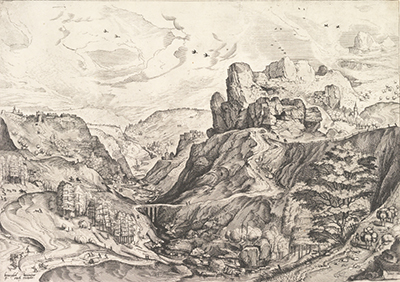Pieter Bruegel produced a series of work known collectively as The Large Landscapes in collaboration with several other artists. They are all dated to around 1555-1556. The item found here was titled Alpine Landscape with Deep Valley.
Within this series of work, Bruegel prefered to leave out any real sign of humanity, focusing entirely on the natural wonder of the region in which he lived. Some were produced away from the Dutch/Belgian region, or at least were based on other parts of Europe, but most were on familiar ground. We find a steep hill to the right hand side which provides a dramatic backdrop, with rolling hills then placed on top. The valley then strikes through the centre of the composition, allowing a considerable contrast in height and strengthening our understanding of this memorable valley. To the left hand side, on the other side of the valley, is a much lower level with simple trees sprouting up in a seemingly unplanned arrangement. There is also one tall tree on the right which visually draws the two levels of the painting together. In the far distance are blurred elements which maybe clouds or even a further collection of taller mountains.
Both the initial plate and also the resultant printed sheet are now owned by the Metropolitan Museum of Art in New York, USA. They do, however, point to the involvement of Johannes van Doetecum as well, suggesting that there is some confusion over the origin of the design as well as possibly it involving more than one person. It is accepted by most, however, that Hieronymus Cock was involved in the print publication process and he was highly respected within this region for his work in this highly specialisted discipline. It would not have made sense for an artist who was skilled in painting or etching to spend large amounts of time and money learning these additional techniques, when they would probably have preferred to concentrate on creating more artworks which was the basis of their income. You will find a similar example with when artists enter ceramics for a short period and choose to call on experts to avoid the expense of purchasing kilns and materials.
It is believed that most of the this series now resides at the Metropolitan Museum of Art in New York, US. This includes both the original engravings as well as the resulting prints. Having been completed so many years ago it is hard to be entirely sure about just how many prints were produced from these designs, with many more likely to exist elsewhere - therefore the biggest value is in the original engraving blocks themselves. It is hard to find too much in-depth information about them, partly due to the extraordinarily large collection now held by this American institution as well as the lack of research that has been completed on Bruegel's work other than his much more famous paintings. The Met itself covers an incredible breath of global art and antiquities too, with some of its highlights including Bernini's Bacchanal, a cast of Rodin's The Burghers of Calais and Bruegel's The Harvesters.




